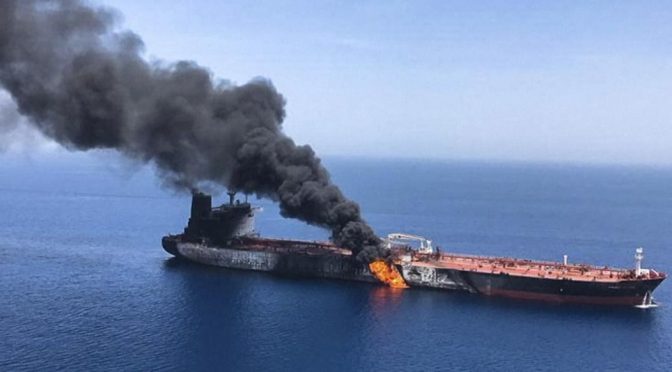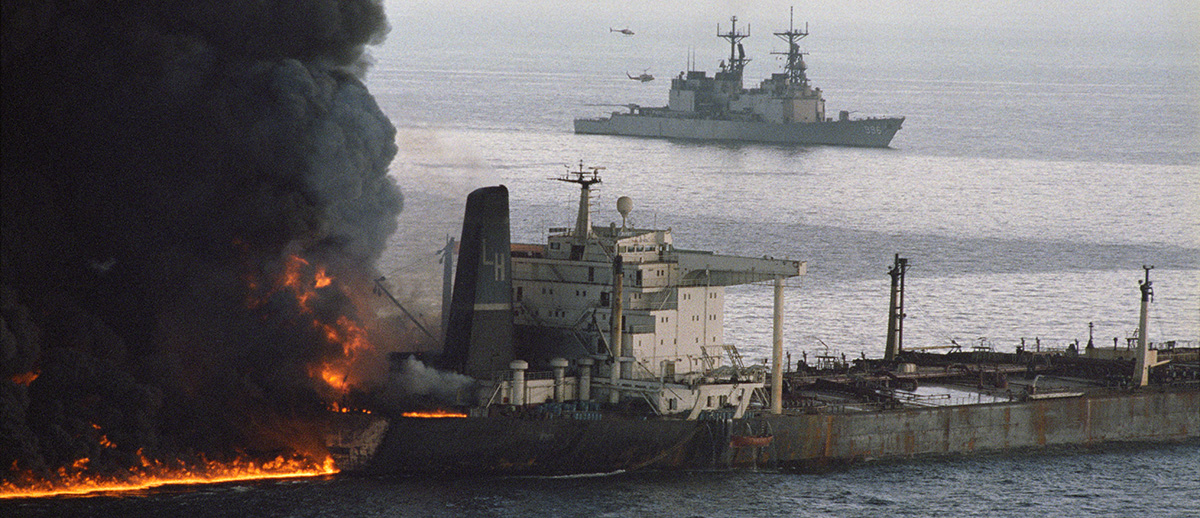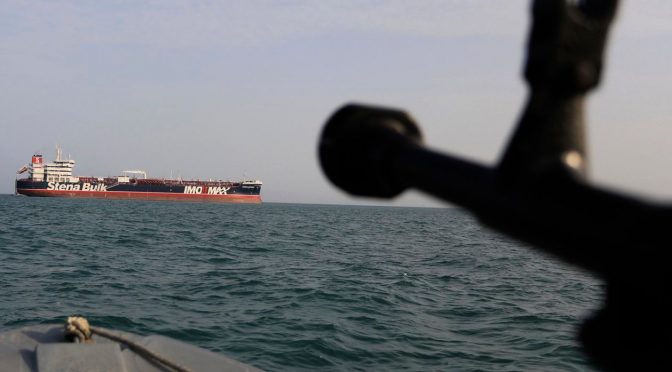By LCDR Arlo Abrahamson, USN
This is a continuation of Part 1, where we introduced the topic, discussed external influences on maritime strategy, and talked about the effects of transparency. Here, in Part 2, we will explore how to synchronize information power to enable maritime strategy, along with several counter-arguments and perspectives.
Synchronizing Information Power to Enable the Maritime Strategy
Another key factor in optimizing public affairs to best support the U.S. maritime strategy is through its synchronization with other aspects of U.S. information power. This is not to assert that synchronization efforts do not exist and are not sporadically effective. While structures are in place to routinely coordinate public affairs actions with both military information operations and public diplomacy, more cross-functional collaboration is imperative in the dynamic information environment where target audiences are increasingly blurred and overlapping.1
The Joint Concept for Operating in the Information Environment manual affirms the lack of coordination between government information disciplines to achieve a fully holistic harnessing of information power, which involves informing the knowledge, attitudes, and behavior of both friends and foes while minimizing the undue influence from adversaries.2 Many operational staffs already have procedures in place that assign public affairs planners to the information operations working group.3 While these working groups enable greater situational awareness of all information functions, it does not necessarily render more holistic strategic communication efforts.4 There is a necessary doctrinal separation that preserves the credibility of public affairs as a broker of truth while information operations may seek more aggressive influence campaigns.5 However, Duane Opperman points out that a significant portion of information operations is legislated in providing factual information to adversary audiences, which provides a nexus for coordination and de-confliction activities with public affairs.6
Within the maritime security sphere, synchronization efforts are particularly important when examining informational attacks from near-peer nations such as China or Russia on the U.S. maritime strategy. For example, the Chinese Communist Party’s propaganda wing, which publishes the Global Times, routinely characterizes U.S. forward naval presence as dangerous and destabilizing for the Indo-Pacific region.7 These stories and narratives by Chinese propagandists make their way into domestic and international press, including U.S. allies and partners, potentially shaping public opinion through specious messaging that can degrade the credibility and perceptions of U.S. naval presence.
As a result, it is essential for military public affairs operations, in pursuit of credible messaging strategies, to collaboratively analyze narratives across the spectrum of U.S. information power to ensure important context and facts are optimized to counter misinformation from strategic competitors and adversaries.8 Kevin Petro, Chief of the Strategic Effects Division on the Joint Chiefs of Staff, notes that commanders can deter and even discredit adversary behavior when credible information and important factual data is messaged holistically.9 For example, in 2017 when a Russian fighter jets flew dangerously close to the destroyer USS Porter while operating in international waters in the Black Sea, the commander and crew presciently documented these unsafe maneuvers and transmitted the imagery to the U.S. European Command, where the imagery was used in diplomatic and media channels to demonstrate Russian aggression and violations of international law.10 As such, the actions of one tactical unit, combined with the synchronization of information by the U.S. government, enabled the misinformation campaigns and misdeeds of an adversary to be countered through multiple prongs of information power and thus maintain the credibility of U.S. forward naval presence.
Counter Arguments and Alternative Perspectives
There are notable alternative perspectives regarding military applications of the information environment, the balancing of transparency with operational security, and synchronization of U.S. information power. National security leaders are increasingly aware of the impact of misinformation campaigns waged against the U.S. via social media and adversary propaganda, which is compelling some commanders to advocate for more latitude to leverage influence operations.11 Brigadier General Dennis Crall, the former Chief Information Officer of the Marine Corps, advocates for a more pointed response to adversary misinformation campaigns while noting influence campaigns should not be taboo to military information professionals:
“When it comes to influence, simply understanding the cognitive domain isn’t enough – you’ve got to do something about it. The ability to influence our adversaries – and, again, in a way of our time and choosing – is critical.”12
Moreover, Opperman contends that credibility concerns in waging influence operations are relative to a given situation.13 Opperman further posits that public affairs functionality concerns of maintaining credibility by shying away from overt influence activities are over emphasized and argues that members of the press and other external stakeholders should understand that “all operations, including public affairs and communications, are part of an overall military strategy.”14
Regarding transparency, a notable cadre of security advocates including Henry Irving and Judith Townend argue that during World War Two, strict government control of military information in otherwise open societies enabled operational success in both Britain and the U.S., and contemporary applications may be appropriate today.15 Irving and Townend contend that operational security has waned via adversaries taking advantage of Western systems of openness in government and military institutions.16 Moreover, Tim Hsia argues that competing goals of secrecy to generate surprise versus transparency create natural friction and mistrust of journalists that compels some commanders to seek caution and avoid press engagements.17 Other analysts attribute a perceived trend toward political punditry and eroding journalistic standards caused by the diffusion of media actors in social media and online web forums as the primary cause of mistrust in relationships with the media.18
There are also ranging philosophical debates about the synchronization of public affairs and information operations with some advocates arguing for extremely limited interaction between the disciplines to those who believe that the two fields should be fully integrated. One theory posits that if public affairs professionals participate in counter information campaigns from adversaries, it would give legitimacy to the enemy’s propaganda and delegitimize public affairs information.19 Conversely, Tad Sholtis argues that public affairs and information operations functions should be more than synchronized, but rather integrated operational functions with the combined capability to reach the audiences of allies, partners, and foes alike.20
The synchronization of military public affairs with public diplomacy functions also invokes debate. Steven Stashwick notes that the size of the Department of Defense and the Navy with their vast resources often creates “mission creep” into traditional State Department functions, to include public diplomacy communication.21 He argues that the State Department, which manages holistic and long-term relationships with a given country, should be laying the groundwork for the initial phases of security cooperation engagements contending that “military access and partnerships all require engagement beyond the parameters of the Department of Defense.”22 Noting the U.S. maritime strategy is primarily executed abroad, all of the aforementioned arguments and alternative perspectives must be addressed and reconciled for the strategy to have long-term success.
Conclusions
Admiral John Kirby contends that when the DoD and the Navy fail to communicate consistently, authentically, and with credibility, the U.S. effectively cedes the narrative to its adversaries.23 Moreover, Davis maintains the best way to counter misinformation and disinformation campaigns is to not act in the same coercive and manipulative manner of U.S. adversaries, but to “double down on our values” – values of truth and transparency that strengthen the U.S. position and ultimately allow its strategies to prevail over time.24
While influence campaigns should not be taboo for information operations, commanders must carefully analyze how any such campaign affects the public domain where their public affairs officers will be operating to ensure long-term credibility and trust are not degraded. This is particularly important in supporting prolonged initiatives such as the U.S. maritime strategy.
Additionally, operational security and promoting U.S. values of openness and transparency do not have to be a point of conflicting goals. Stavridis notes that commanders can speak comprehensively about the U.S. Navy’s capabilities, strategic presence, and partnerships without giving away tactics, techniques, and procedures:
“Without in any way revealing secrets, it is possible to engage the global media to showcase U.S. military capabilities. All that helps create real deterrence by giving potential enemies pause. It also encourages allies to stay on our team.”25
Moreover, while one might argue that reporters are difficult to work with and sometimes do things the military does not like, the same may be said for external relationships of all kinds to include U.S. allies and partners, but commanders still engage with them, as they understand that relationships with allies and partners impact operational success.
The equation is no different with the relationships with the press. Difficult relationships are not an excuse for transparency to wane.
While there are numerous arguments about how public affairs can synchronize efforts with information operations and public diplomacy channels, the principal function of public affairs as a trusted intermediary between the military and the media is imperative for maintaining a credible voice in press coverage that impacts the success or failure of U.S. naval strategies. In an era where truth is often blurred by adversary misinformation and disinformation campaigns, there is even more precedent for public affairs to function as the primary purveyor of credible information that the Navy’s public stakeholders can trust. Accordingly, the value of thoughtful, factual, and contextual messaging that deters adversaries and helps maintain the support of allies and partners affects the ability for naval forces to effectively operate at the strategic, operational, and tactical levels. As Navy ships in particular are sovereign representations of national power, the public perception of deterrence and confidence in U.S. capabilities impacts even one U.S. ship operating in a forward operating environment.
Notwithstanding, it is imperative that public affairs professionals cooperate and synchronize factual messaging with information operations and public diplomacy nodes of U.S. information power. And yes, there are times when it is more appropriate for public diplomacy personnel to lead communication on various aspects of military operations as it relates to nation-to-nation relationships. Yet none of this rationale precludes the impact and requirement for a credible intermediary that an optimized military public affairs function can provide for the Navy to pursue its maritime strategy.
As such, the best way to ensure that public affairs programs can support the maritime strategy is to ensure the Department of Defense and the Navy remain a credible and trusted arbitrator of information, to promote transparency in an authentic and balanced manner with operational security, and to synchronize information yet maintain distinctly separate lines between public affairs and information operations. This modality for public affairs must be standard across the strategic, operational, and tactical levels to be effective. It will require commanders, public affairs officers, and operators to understand and align their public affairs programs in a unified and consistent manner. Communicating consistently and thoughtfully must be a priority and leaders must lean forward and take some of the same calculated risks with public communications as they do in other military operations when opportunities are presented to enhance strategic narratives. In this approach, public affairs can be optimized to effectively support the U.S. maritime strategy and the long-term viability of the U.S. Navy.
Lt Commander Arlo Abrahamson is a recent graduate of the Naval War College and a career Navy public affairs officer. He has served globally supporting strategic communication, security cooperation, and public diplomacy initiatives for the U.S. Department of Defense and Department of State. These views are his own and do not necessarily reflect the official position of the U. S. Government or the Department of Defense.
Endnotes
1. John Kirby, “The Information Environment Today,” lecture filmed May 2016 at the Naval War College, Newport R.I., video, 30:58, https://www.youtube.com/watch?v=ZYyoRo5_Alw
2. Chairman Joint Chiefs of Staff, Joint Concept for Operations in the Information Environment, (Washington, DC: GPO, July 25, 2018), 1-4.
3. Chairman of the Joint Chiefs of Staff, Joint Publication 3-13, Information Operations, (Washington DC: GPO, November 2012).
4. Chairman Joint Chiefs of Staff, Joint Concept for Operations in the Information Environment, (Washington, DC: GPO, July 25, 2018), 1-4.
5. Chairman of the Joint Chiefs of Staff, Joint Publication 3-61, Public Affairs, (Washington DC: GPO, November 17, 2015),1-14.
6. Duane Opperman, “Information and Public Affairs: A Union of Influence,” U.S. Army War College Strategy Research Project Paper, (March 22, 2012): 7, https://apps.dtic.mil/dtic/tr/fulltext/u2/a561834.pdf.
7. Junshe Zhang, “U.S. Meddling Disrupts Peace in South China Sea,” Global Times, July 25, 2017, http://www.globaltimes.cn/content/1057993.shtml.
8. Duane Opperman, “Information and Public Affairs: A Union of Influence,” U.S. Army War College Strategy Research Project Paper, (March 22, 2012): 5.
9. Kevin Petro, Colonel, U.S. Army, Joint Staff, email correspondence with author, April 17.
10. Ivan Watson, Sebastian Skukla, “Russian Planes Buzz U.S. Warship in Black Sea,” CNN, Feb 16, 2017, https://www.cnn.com/2017/02/16/us/russia-us-ship-fly-by/index.html.
11. John Kirby, Rear Admiral (ret), email correspondence with the author, April 16, 2019.
12. Gidget Fuentes, “Marine CIO: Don’t Fear Deception in the Information Warfare Mission,” USNI, Feb 27, 2107, https://news.usni.org/2017/02/27/marines-cio-dont-fear-deception-information-warfare-mission.
13. Duane Opperman, “Information and Public Affairs: A Union of Influence,” U.S. Army War College Strategy Research Project Paper, (March 22, 2012): 9 https://apps.dtic.mil/dtic/tr/fulltext/u2/a561834.pdf.
14. Ibid, 6.
15. Henry Irving, Judith Townend, “Censorship and National Security: Information Control Second World War and Present Day,” History and Policy.Org, February 10, 2016, 1-4, http://www.historyandpolicy.org/policy-papers/papers/censorship-and-national-security-information-control.
16. Ibid.
17. Tim Hsia, “The Uneasy Media/Military Relationship,” New York Times At War Blog, June 15, 2011, https://atwar.blogs.nytimes.com/2011/06/15/the-uneasy-media-military-relationship/.
18. Margaret Sullivan, “More Facts, Fewer Pundits: Here’s how the Media can Regain the Public’s Trust,” Washington Post, Jan 17, 2017, https://www.washingtonpost.com/lifestyle/style/more-facts-fewer-pundits-heres-how-the-media-can-regain-the-publics-trust/2017/01/29/9c0232ba-e4a7-11e6-a453-19ec4b3d09ba_story.html?noredirect=on&utm_term=.1d0ec7dc854e.
19. “Information Operations and Public Affairs,” Small Wars Journal, Aug 2012, https://smallwarsjournal.com/blog/public-affairs-and-information-operations
20. Tad Sholtis, “Public Affairs and Information Operations, a Strategy for Success,” Air and Space Journal, (Fall 2005):10-14.
21. Steven Stashwick, “The Militarization of Foreign Policy: The Military Mission drives Foreign Engagement,” EastWest Center Forum, Jan 31, 2017, https://www.eastwest.ngo/idea/militarization-foreign-policy-military-mission-drives-foreign-engagement-part-i.
22. Ibid.
23. John Kirby, Rear Admiral (ret), email correspondence with author, April 15, 2019.
24. Jeff Davis, “Retirement Remarks – The Future of Public Affairs,” Linked In, Oct 2019, https://www.linkedin.com/in/jeff-davis-07624a76/.
25. James Stavridis, “It’s been over 300 days since a Pentagon Press Briefing: That should concern all Americans including the Military,” Time Magazine, April 16, 2019, http://time.com/5571643/pentagon-press-briefings/.
Featured Image: NORFOLK, Va. (June 13, 2019)–Capt. David Murrin (left), UNSN Comfort’s ship’s master, Capt. B. J. Diebold (center), USNS Comfort’s mission commander and Capt. Kevin Buckley, USNS Comfort’s medical treatment facility commanding officer address members of the media during a press conference, at Naval Station Norfolk, prior to the hospital ship’s deployment to South America, Central America and the Caribbean, June 13.(U.S. Navy photo by Shevonne Cleveland/released)





